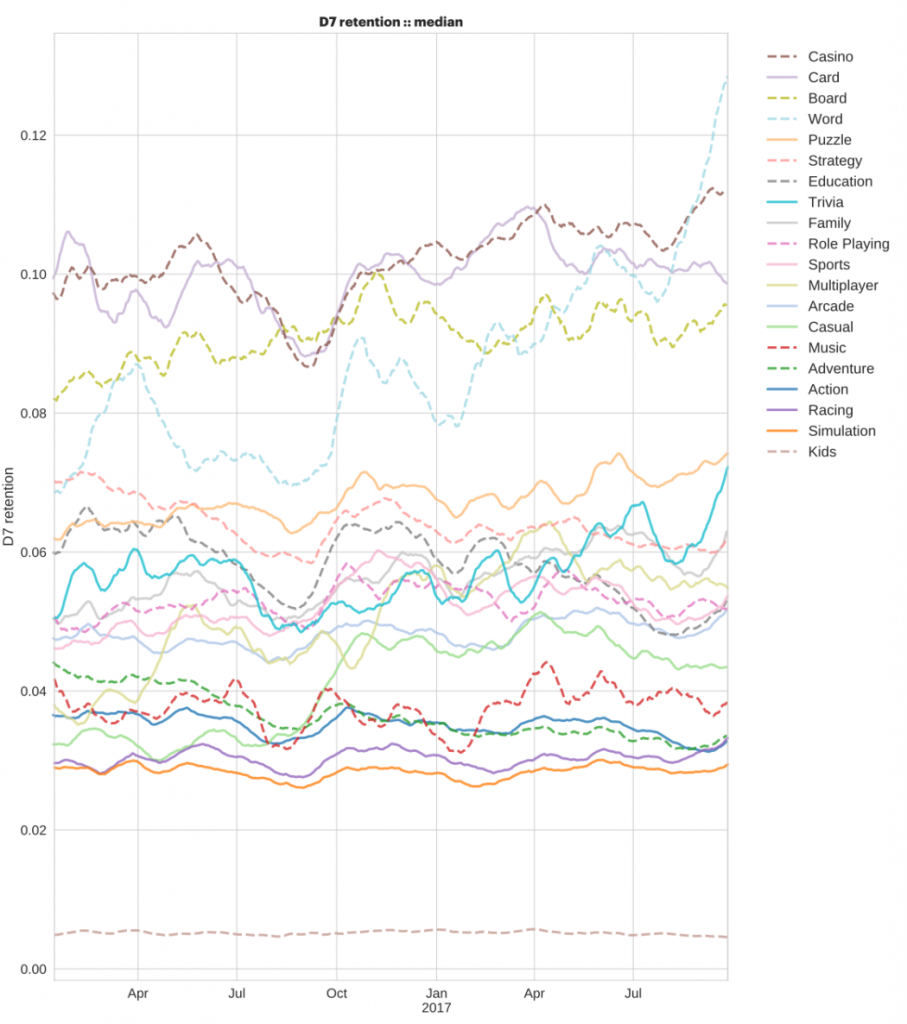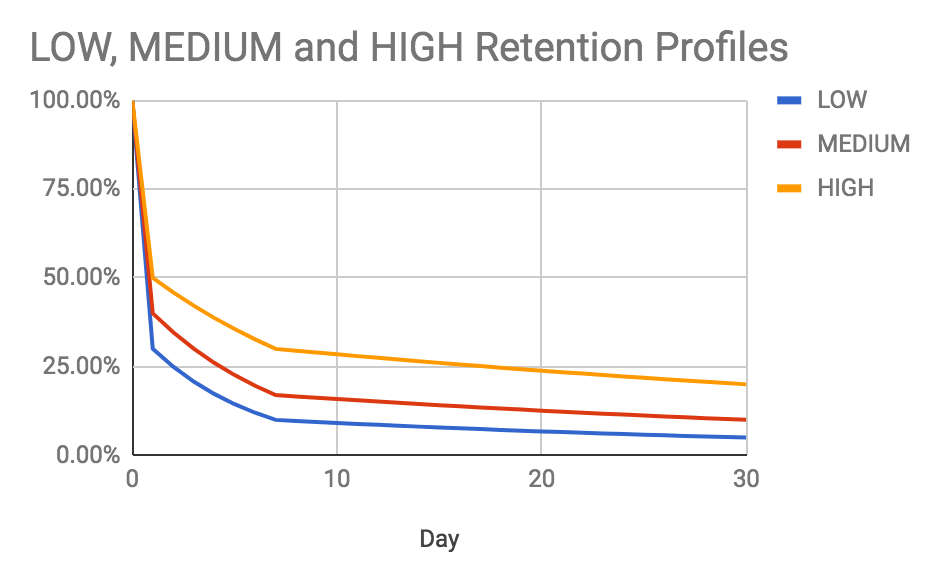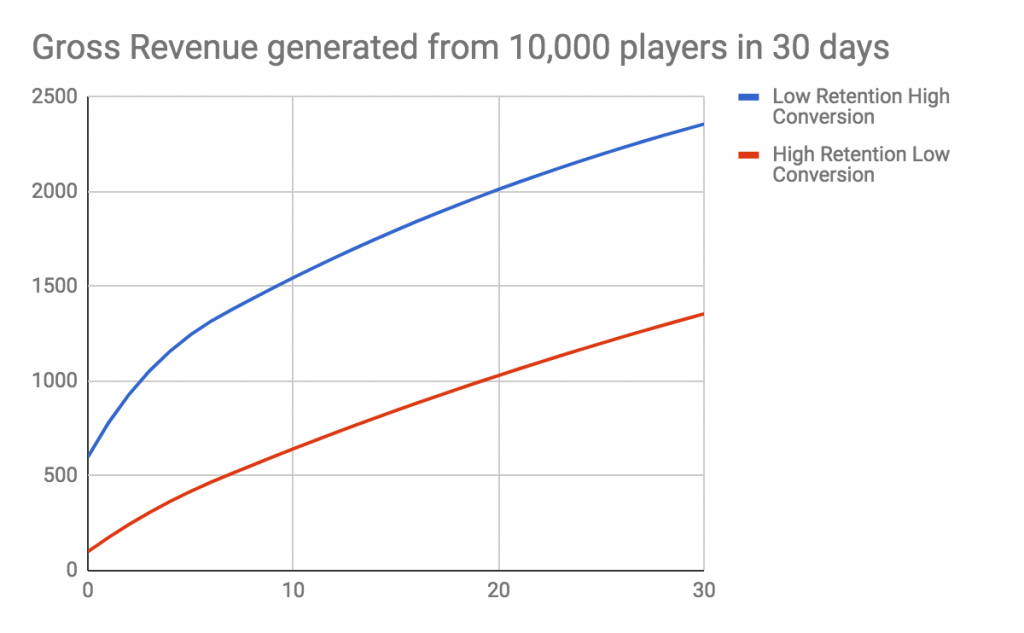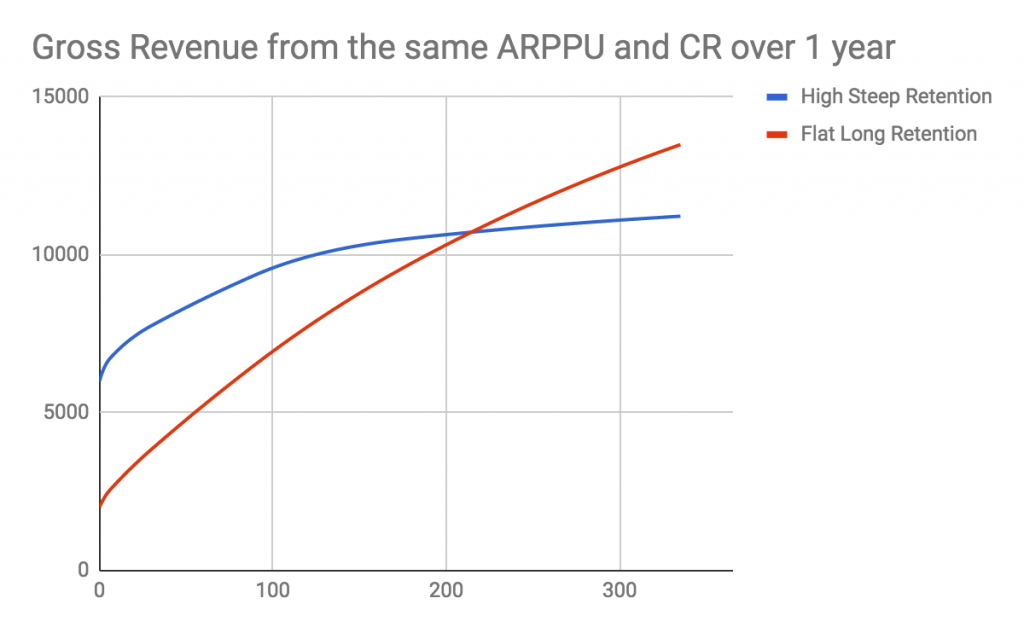Por qué obsesionarse con las métricas de retención corre el riesgo de acabar con su juego
Para muchos desarrolladores, la retención de jugadores se considera la métrica más importante para un juego gratuito. Todas las empresas de juegos se obsesionan con alcanzar una retención cada vez mayor para garantizar que su base de usuarios crezca y crezca.
Semanalmente, escucho a los desarrolladores preguntar "¿A qué nivel de retención debería aspirar?" o "¿Qué retención del día siete (D7) se necesita para que consigamos un acuerdo de publicación?". Sin embargo, la verdadera pregunta que deberían hacerse es: ¿debería un solo número decidir el destino de su último prototipo?
Cuando pienso en la retención, me gusta pensar en la analogía de las millas por galón (MPG) en el motor de un automóvil: cuanto mayor sea la retención, mayor será el MPG y más eficiente será el motor de su juego. Los ingresos y el marketing son el combustible que impulsa este motor, por lo que mi consejo es que esté seguro antes de pisar el acelerador.

La lección clave es que los juegos con mayor retención llegan más lejos por menos. Sin embargo, así como hay autos construidos para muchos propósitos diferentes y destinados a diferentes usuarios, hay muchos juegos para muchos jugadores; no todos los autos necesitan MPG altos. Un hot-rod puede ser el coche más rápido del mundo, pero requiere un pequeño pozo de petróleo para seguir funcionando. Un SUV familiar cumple múltiples propósitos a costa de su eficiencia, y un Tesla Model 3 elimina por completo las MPG.
Sucede más o menos lo mismo con los juegos gratuitos: diferentes géneros tienen diferentes perfiles de retención y diferentes juegos monetizan en diferentes puntos del embudo. Del mismo modo, los diferentes modelos de negocio dependen de que diferentes audiencias interactúen durante diferentes períodos de tiempo.
En cada caso, no existe una única curva de retención que sea el modelo correcto, simplemente un perfil de retención que indica dónde su juego es más débil. Entonces, en lugar de centrarse en los números en sí, busque los días de la curva que tienen la mayor caída relativa, ya que este puede ser el punto donde se pierde gente más rápidamente. Durante un lanzamiento suave es el punto crítico donde se pueden tomar decisiones importantes para continuar: a menudo son las métricas de retención las que deciden el destino de tu juego, pero se presta muy poca atención a las señales de monetización aún más débiles.

Fuente: Puntos de referencia de juegos móviles de GameAnalytics 2016-2017
La monetización importa
Para que un juego gratuito sea un producto exitoso, debe monetizarse. Durante los primeros días del lanzamiento de un nuevo prototipo, tendrá muy pocos puntos de datos para realizar una llamada, pero deberá ver cierta monetización por parte de algunas personas. Concéntrate en la tasa de conversión y el ARPPU que recibes: estos dos factores ayudan a dar una idea de lo que podría pasar si el juego escalamos.
Monetisation only occurs when your game’s system is appealing enough for someone to spend, and the amount they spend is the only real signal you have to how much value your product could create. Spend doesn’t need to equate directly to an IAP, but also how many unique players watched an ad or signed up to a subscription. In each case, the number itself isn’t as valuable as what it results in: Gross Revenue. I would argue that the more important metrics to consider when evaluating early prototypes are Conversion Rate (CR) and Revenue per paying user (ARPPU) as these small signals show that your engine is working.
Returning to the analogy of Miles per Gallon, increased MPGs are a result of a more efficient engine. Conversion Rate and ARPPU are like fueling the tank with gas – the more gas you get the less efficient you need to be. However, it’s admittedly difficult to work out early on justwhen your engine is ready to take to the streets.
Each metric is only a signal: it gives you a rough overview of your games abilities. In order to build better games, you must focus on the components, not the metrics that show the signal. Only if each component is optimised to its specific goal will you start to see improvements in your metrics, the most general of which is retention. Just like a car engine has pistons, turbos and exhausts that contribute to its overall efficiency, your game has FTUE, Clear UIs and Desirable characters to collect. A real jump in MPGs comes when as a game designer you appreciate the interplay between these features, and realise which of your designs is weakest.

Don’t get me wrong – retention is a fundamental driver of success on any app store, but this obsession with the number your game needs to hit is not how you build a better game. Indeed, improving retention is something we’ve written about it on multiple occasions.
Life Time Value


LTV (Life Time Value) of a gamer is fundamentally what allows you to call a game a success or failure – a high enough LTV allows profitable marketing and growth of your game. However, by its very nature it is an estimation of future value – it can give horribly inaccurate signals early on during testing. There are also many different methods used to calculate it across large time periods.
The equation above focuses on 30D, simplified LTV – LTV is driven on the one hand by revenues (fuel) and on the other side retention (efficiency) with a time estimation for the future value of a player (discount rate). You can read more about methods for calculating LTV here. Too much focus is given to the early retention metrics of the equation, because it’s easiest to gather with small amounts of data, but without any revenue signals being present there is no fuel to grow the LTV.

CR and ARPPU are not accurate measures for generating robust models, but they do provide simple signals for game designers.
Conversion Rate is a clear indication of necessity and desire – it’s a signal showing just how many players want to invest in your product, understanding exactly when they bought and what they bought can help you optimise your design funnels to make purchasing clearer for future players.
ARPPU is a strong indicator of pricing and value. You need to ensure that when someone does convert they are giving you the most that they would be willing to pay for content in your game, not converting for an overlygenerous bargain. Quickly testing multiple price points for your game’s economy can greatly increase your gross revenue.
If you take a look at games with low retention but high CR and high ARPPU then you can still have a workable product on your hands because you’ve seen your gameplay converting players into payers. There may be a huge host of other issues with your funnels and your onboarding, but the fundamental pinch within your system has led to a willing payer. Observing these weak signals early on can give you faith in your early prototype
What retention metrics do tell you
Retention is a fundamental factor in LTV calculations – higher values are always better – but, as we’ve seen, exact figures vary greatly per genre. No matter what your retention curve looks like it won’t directly affect your monetization design. What you ask a player to buy and whether they buy it is a personal decision for each and every gamer. Making that decision clear, simple, desirable and valuable will maximise your conversion.
So what can retention tell you?
Retention metrics are still incredibly useful as gauges for assessing where to focus your game design time. Let’s take D1, D7 and D30 – the most common metrics:
- D1 retention shows me the desirability of your game – fun games are desirable, and people will happily play again tomorrow without the need of much investment or prompting.
- D7 retention shows me the core loop in your game – do they have a clear goal? Do they engage with your systems? Do they form strategies?
- D30 retention shows me whether your core loop scales – Do people have enough content? Can they set long-term goals? Do they get stuck and still want to play more?
In each case, it’s not just the number that’s important, it’s the speed at which the retention drops – the steepness of the curve, if you will. Wherever the steepest drop descends, is where your game is currently weakest. The ideal scenarios is to reach a flat and stable base that is maintained for 60, 90, 180 or even 360 days into the future. When you predict revenues for the long term, even a significantly lower starting retention provides much higher gross revenue over the long term.

Los primeros 'bambaleos' en la curva de retención apuntan a problemas de juego. Por ejemplo, es posible que su economía se haya expandido demasiado o que los jugadores simplemente hayan llegado al final de su contenido más rápido de lo que esperaba. En estos casos, puede utilizar estos puntos de entrega en el perfil para regresar y agregar más profundidad a sus diseños.
La retención es una de las métricas más fáciles y confiables de obtener durante un lanzamiento suave, pero no permita que controle su desarrollo, creatividad o capacidad de toma de decisiones: use la retención como barómetro para señalar problemas más profundos en el diseño de su juego. En esencia, concéntrate en comprender qué impulsa a tus jugadores a gastar dinero. Incluso las señales más débiles pueden demostrar que tienes un producto potencial entre manos, así que deja de centrarte directamente en los números y busca tendencias más amplias (los patrones o fluctuaciones en las cifras) para ayudarte a planificar el diseño de tu juego. Lo último que quieres hacer es enviar un gran juego al depósito de chatarra.
Leave a Reply